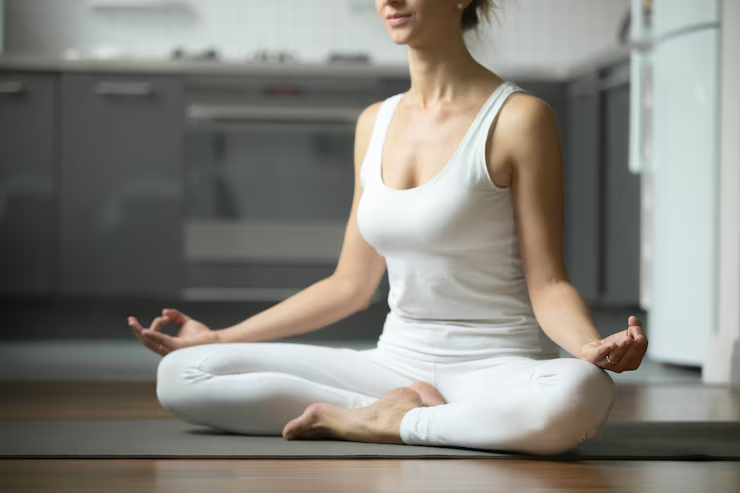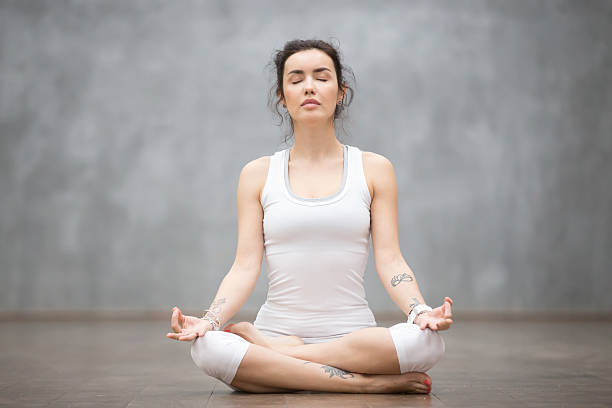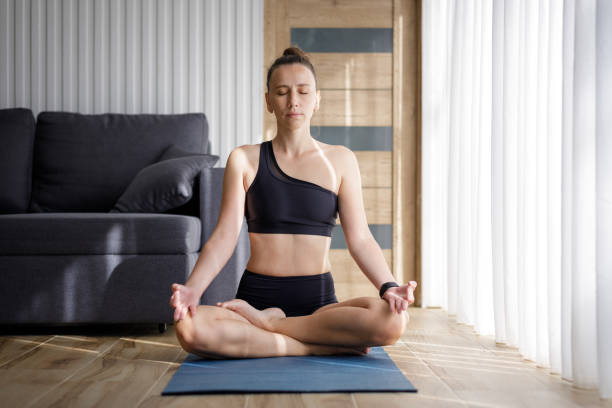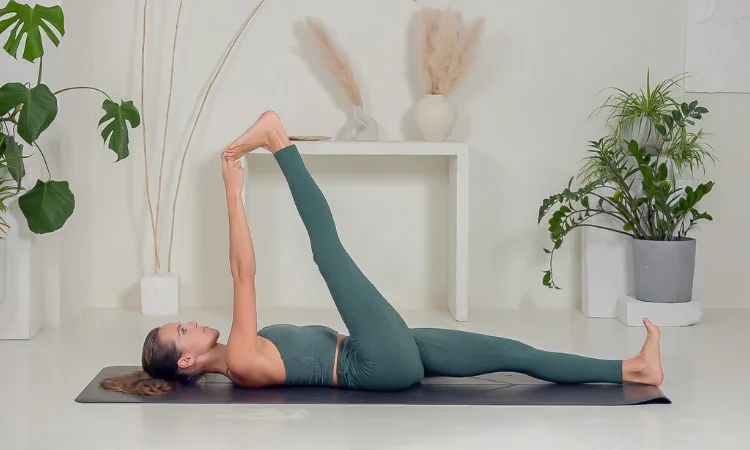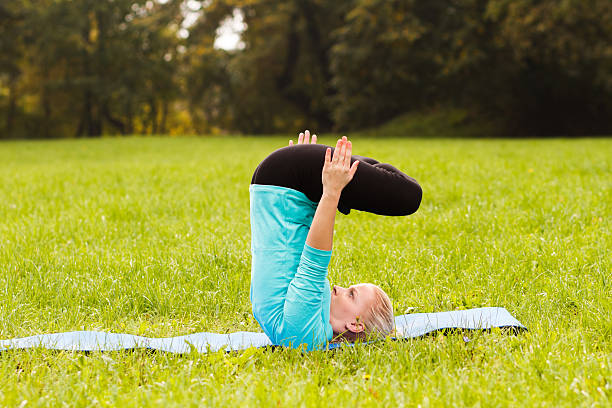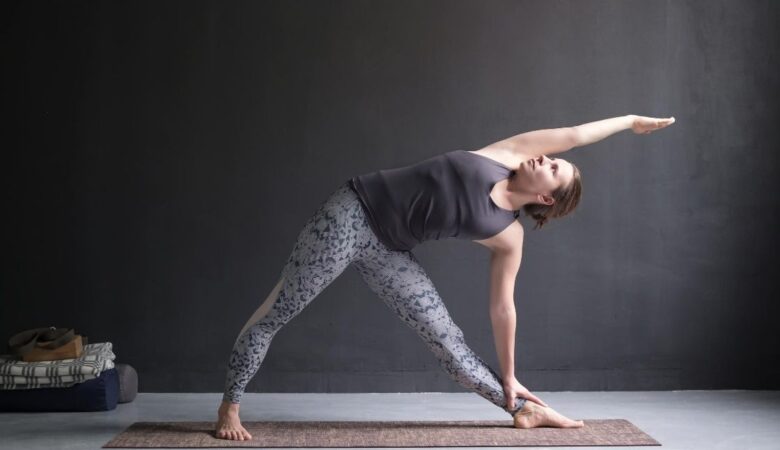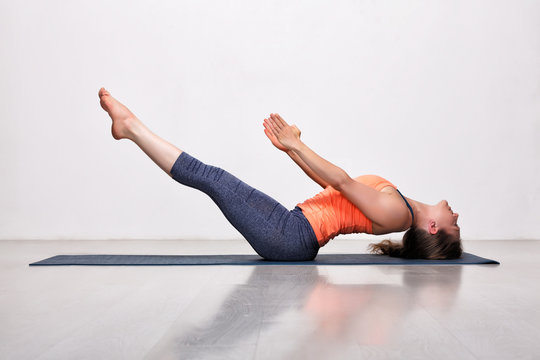Siddhasana is a traditional seated posture in yoga and meditation known for its stability and spiritual significance. Often called the “Perfect Pose” or “Accomplished Pose”, it is described in ancient yogic texts as the most effective posture for meditation, breath control (pranayama), and inner awakening. So, see below the details of Siddhasana or Accomplished Pose
Table of Contents
What is Siddhasana or Accomplished Pose?
Siddhasana, also known as the Accomplished Pose, is a classical seated yoga posture primarily used for meditation and pranayama (breath control). It is one of the most revered and effective meditative poses in traditional Hatha Yoga and is mentioned in several ancient yogic texts as a key posture for spiritual advancement.
Siddhasana thus means “the posture of the accomplished ones” and is said to be used by ancient sages and yogis to attain spiritual powers (siddhis).
- Siddha = Accomplished or perfected being
- Asana = Pose or posture
The name Siddhasana implies that this posture is favored by siddhas, enlightened or spiritually accomplished beings, and that practicing it can help one attain spiritual perfection.
Purpose and Use:
Accomplished Pose is mainly practiced for:
- Meditation (Dhyana)
- Breathwork (Pranayama)
- Spiritual discipline (Tapas)
Energy control and awakening the chakras
It is particularly beneficial for yogis aiming to go beyond physical exercise into the realms of inner awareness and consciousness.
Preparatory Poses:
Before attempting Siddhasana, warm up the hips, knees, and ankles with poses like:
Step-by-Step Instructions To Do Siddhasana:
Siddhasana is more than just a seated posture; it’s a tool for transformation. Physically grounding, mentally calming, and spiritually elevating, it bridges the gap between the body and the soul. With regular practice, Accomplished Pose cultivates the stillness and strength needed for deep meditation and inner mastery.
Step 1:
Sit in Dandasana (legs extended forward).
Step 2:
Bend the left leg and bring the heel to the perineum (between the anus and genitals for men; against the labia majora for women).
Step 3:
Bend the right leg, placing the right heel directly above the left heel or in front of the pubic bone. The sole should touch the inner thigh.
Step 4:
Tuck the toes of both feet into the gaps between the thighs and calves if comfortable.
Step 5:
Keep the spine straight, shoulders relaxed, and head aligned.
Step 6:
Place your hands on your knees in Chin Mudra or Jnana Mudra.
Step 7:
Close your eyes, relax your body, and begin deep breathing or meditation.
Duration:
- Beginners: 3–5 minutes
- Advanced: 30 minutes or longer
- Practice daily and gradually increase duration for best results.
Benefits of Siddhasana or Accomplished Pose:
Siddhasana, one of the most important classical meditative postures in yoga, is highly valued for both physical stability and spiritual advancement. Unlike many asanas focused on flexibility or strength, Accomplished Pose is revered for its ability to prepare the practitioner for deep meditation, energy control, and inner stillness.
Enhances Meditation and Concentration:
The pose creates a stable and comfortable base for long periods of stillness, essential for deep meditation.
Reduces Restlessness:
With the legs locked and spine upright, body movements are minimized, helping calm the mind.
Promotes Inner Focus:
The posture naturally draws attention inward, aiding in mindfulness and concentration.
Keeps the Spine Aligned and Chest Open:
Accomplished Pose keeps the spine aligned and chest open, allowing the lungs to fully expand and contract.
Encourages a Balanced Breath Rhythm:
Encourages a balanced breath rhythm, which is essential for effective practice of pranayama techniques.
The locked lower body creates a grounded sensation, which helps in energy control during bandhas and kumbhakas (breath retention).
Activates Energy Channels or Nadis:
According to yogic physiology:
- The Sushumna Nadi (central energy channel) runs along the spine and is activated when the spine is erect and the lower energy centers are stimulated.
- Accomplished Pose is said to stimulate the Muladhara Chakra (root chakra), facilitating the upward flow of Kundalini energy.
Improves Posture and Spinal Alignment:
The pose promotes natural curvature of the spine, reducing strain on the lower back. Over time, regular practice leads to better posture even outside of meditation or yoga. Prevents slouching and associated back/neck pain.
Strengthens and Opens the Lower Body:
Opens hips and increases flexibility in the knees and ankles. Strengthens pelvic floor muscles by engaging the perineum. Improves circulation in the pelvic and abdominal region, benefiting organs such as the bladder, intestines, and reproductive system.
Promotes Mental Calmness and Stress Relief:
The symmetry and stillness of the pose help the mind enter states of deep relaxation. Reduces anxiety, stress, and agitation by calming the nervous system.
When combined with deep breathing or mantra chanting, it enhances emotional balance and mental clarity.
Increases Endurance for Long Seated Practices:
Unlike many postures, Siddhasana allows practitioners to sit for prolonged periods without excessive discomfort or movement.
- Long meditation sessions
- Scriptural study (svadhyaya)
- Chanting (japa) and mantras
Prepares the Body for Advanced Yogic Practices:
Siddhasana lays the groundwork for:
- Bandhas
- Mudras
- Kundalini awakening
Serves as the foundation for more advanced pranayama and dhyana techniques.
Precautions:
- Avoid if you have: Knee or ankle injuries, Hip stiffness, or joint issues
- Do not force the feet into position; flexibility must be developed over time
- Use a cushion under the hips for better comfort and spinal alignment
- If numbness or tingling occurs, release the posture and gently stretch the legs
Variations & Modifications:
- Ardha Siddhasana or Half Siddhasana: One leg folded and the other placed loosely on the floor – ideal for beginners.
Conclusion:
Siddhasana is more than just a seated posture; it is a gateway to inner stillness, spiritual progress, and yogic mastery. It balances the body and mind, making it a cornerstone of traditional yoga and meditation practices.
Whether you are a beginner seeking a stable meditation seat or an advanced yogi deepening your spiritual journey, Siddhasana offers the perfect foundation.
FAQ:
Q. What is Siddhasana used for?
A. Siddhasana is primarily used for meditation and pranayama. It provides a stable base for prolonged sitting, helps maintain spinal alignment, and supports mental stillness, concentration, and energetic awakening.
Q. Is Siddhasana better than Padmasana?
A. Both have their benefits:
- Siddhasana is often easier to master and more accessible to most practitioners.
- Padmasana (Lotus Pose) requires more flexibility and may be more intense on the knees.
Accomplished Pose is considered more suitable for pranayama and energy regulation, while Padmasana is commonly preferred for deep meditation.
Q. Can beginners do Siddhasana?
A. Yes. Siddhasana is more beginner-friendly than other advanced seated postures like Padmasana. However, if flexibility in the hips, knees, or ankles is limited, beginners can start with Ardha Siddhasana (Half Siddhasana) or use props like cushions.
Q. How long should I sit in Siddhasana?
- Beginners: Start with 5–10 minutes
- Intermediate: Aim for 15–30 minutes
- Advanced: Practitioners may sit for an hour or more during deep meditation or pranayama.
Listen to your body and build duration gradually.
Q. Is Siddhasana safe for everyone?
A. Siddhasana is generally safe, but it should be avoided or modified if you have:
- Knee or ankle injuries
- Severe hip stiffness
- Circulation issues in the legs
Always consult a yoga instructor or therapist for modifications if needed.
Q. Can I use a cushion or prop in Siddhasana?
A. Yes. Using a folded blanket or cushion under the hips helps elevate the pelvis, making the posture more comfortable and easing pressure on the knees and ankles.
Q. What does the yoga scripture say about Siddhasana?
A. According to the Hatha Yoga Pradipika:
This shows its supreme importance in classical yoga as a gateway to spiritual realization.
Q. Can women practice Siddhasana?
A. Yes. There is even a gender-specific version called Siddha Yoni Asana for women, with minor anatomical adjustments. The practice and benefits remain largely the same.

